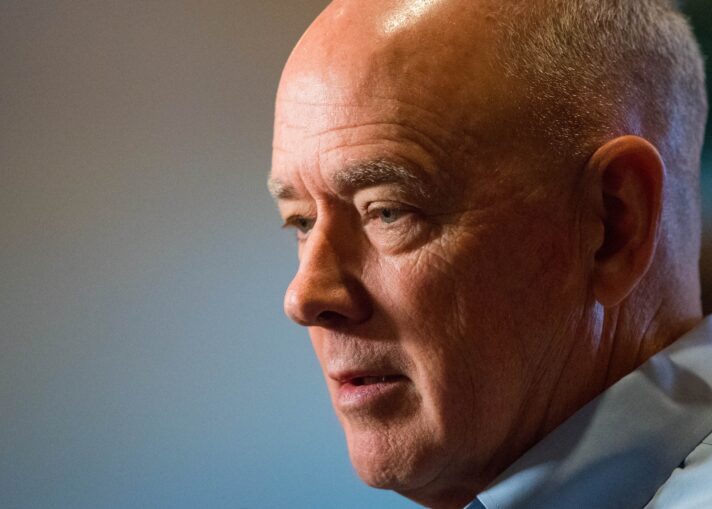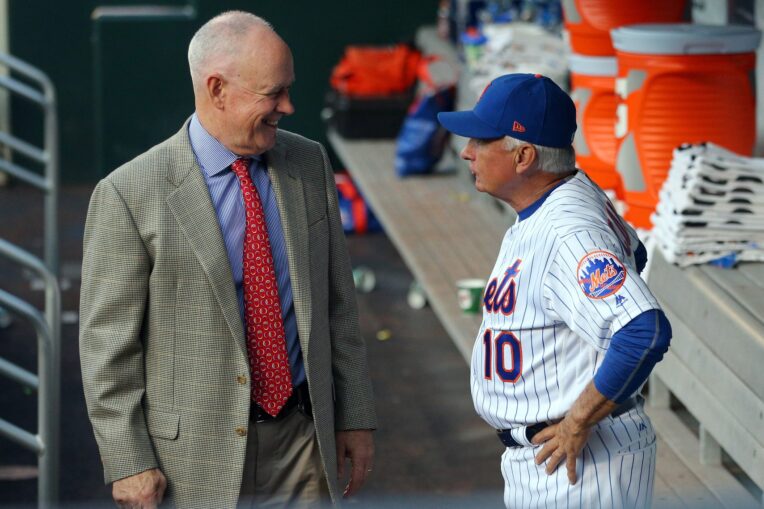
Sandy Alderson has seen it all. From his undergraduate days at Dartmouth, to his law school years at Harvard to his stint in the U.S. Marine Corps, to his 30-odd years as an executive in Major League Baseball, Richard Lynn “Sandy” Alderson has seen it all.
From frugal owners to wealthy ones, from good organizations to bad, from the top of the heap to the depths of despair, Alderson has been a part in nearly all baseball scenarios possible for a front office manager. Through all this and more, Alderson, who will turn 73 on November 22, has the reputation of a baseball savant, at times innovative, at times creative and at times brilliant, especially with organizations in transition.
Now, this architect of franchises will likely be joining the New York Mets as team president. The “if” here of course is if prospective owner Steve Cohen gets the necessary votes by current owners to take control of the Mets’ franchise. Certainly, this announcement by Cohen is only meant to augment his chances. He said in a statement on Thursday:
“If I am fortunate enough to be approved by Major League Baseball as the next owner of this iconic franchise, Sandy Alderson will become president of the New York Mets and will oversee all Mets baseball and business operations,” Cohen’s statement read. “Sandy is an accomplished and respected baseball executive who shares my philosophy of building an organization and a team the right way. I am excited to have Sandy in a key leadership role with the Mets if my purchase of the team is approved.”
Few executives will deny the influence and impact Alderson wields and the respect he’s garnered through three decades of baseball experience. No doubt the timing of Cohen’s announcement can only be seen as a way to bolster his viability.
Sandy Alderson’s first job in professional baseball was as general consul to the Oakland Athletics in 1981. Two years later, he was named as general manager of the team. He had a flexible payroll which was always in the top third of baseball. In 1991, he has baseball’s highest payroll. During this time, Alderson rebuilt the A’s farm system drafting players such as Jose Canseco, Mark McGwire and Walt Weiss all of whom were named Rookie-of-the-Year in consecutive seasons starting in 1986.
The Athletics won four division titles, three pennants and the 1989 World Series during Alderson’s tenure.
In 1995, team owner Walter A. Haas, Jr. died and was replaced by Stephen Scott and Ken Hofmann. The new owners asked Alderson to slash payroll and because of this, more focus was placed on sabermetric principle to try to find undervalued, less expensive players. Alderson left the A’s to join the commissioner’s office in 1998.
Billy Beane, who worked as an assistant under Alderson for a decade, took over as GM of the A’s after his old boss left. He credits Alderson for much of his success noting:
“He was the first guy who really introduced me to a lot of the… analytics stuff. He was the first one who had me look at things asymmetrically, as opposed to the way we’d always done it,” Beane told Tim Britton of The Athletic in 2018. “The reason I looked at the game differently was because I worked with Sandy.”
After serving as Executive Vice President for Baseball Operations for seven years, Alderson stepped down from the commissioner’s office to become the Chief Executive Officer of the San Diego Padres in 2005. In the five seasons he was in San Diego, he rebuilt a team that lost 98 games in 2003 to a team that won their division in 2005 and 2006.
At the end of the 2010 season, Sandy Alderson was hired by the New York Mets. He was officially introduced as general manager on October 29, 2010. He signed a four-year deal with a club option for a fifth. Mets owner Fred Wilpon was in the middle of the fallout from the Madoff investment scandal and told his new GM he had a limited budget.
Undeterred, Alderson brought two of his lieutenants with him, J.P. Ricciardi and Paul DePodesta, and told them, “This is going to be tough. But how sweet is it going to be if we succeed in New York City? It’s going to be great fun.” (Britton)
Well, it wasn’t always fun. In his eight year tenure with the Mets, he had only two winning season, one division championship, one pennant and a World Series appearance in 2015. He was named Baseball America Executive of the Year in 2015.

Alderson’s strength was as a deal maker. He executed three of the best trades in recent Mets history, landing Zack Wheeler for Carlos Beltrán at the 2011 trade deadline, bringing in Noah Syndergaard and Travis d’Arnaud in return for R.A. Dickey after Dickey’s Cy Young season in 2012, and acquiring Yoenis Céspedes for Michael Fulmer and Luis Cessa at the 2015 trade deadline.
Alderson was also instrumental in the seven-year contract extension for David Wright in December 2012. The deal was valued at $138 million. Wright’s deal was contrary to the Mets budget-conscious policy of not offering large contracts. Nonetheless, Alderson made an exception as he viewed Wright as a leader and role model, on and off the field. Although it had been six years since the Mets’ last playoff appearance and four years since their last winning season, Alderson managed to persuade Wright to stay, as the Mets’ farm system had many young, talented pitchers.
Many of these pitchers were drafted by Alderson’s predecessor, Omar Minaya, and these arms were greatly responsible for the Mets 2015 playoff drive.
But Alderson drafted a few good players of his own. The clubs talent level has improved, driven by players initially acquired by Alderson — prospects who have become quality everyday players like Michael Conforto, Pete Alonso, Jeff McNeil, Brandon Nimmo and Dominic Smith.
Some fault Alderson with his free-agent dealings. He made an error in judgement when he signed Michael Cuddyer at the expense of a first-round draft pick before the 2015 season. He also allowed Daniel Murphy to sign elsewhere following 2015, although some debate to this day, the merits of the Murphy move.

Ahead of the 2011 season, Alderson hired Terry Collins as manager and he won the second-most games of any manager in Mets history. He was criticized for keeping him too long by some, but he uttered to reporters at the time, “Don’t assume I had the authority to fire him, solely.”
Alderson certainly garnered more criticism with his hire of Mickey Callaway at the end of the 2017 season.
Alderson was diagnosed with an undisclosed form of cancer in 2015. He stepped down from the Mets after a recurrence in 2018. He told reporters, “With respect to the future, I would say two things: One is, notwithstanding the good prognosis, my health is an uncertainty going forward And secondly, if I were to look at it on the merits, I’m not sure coming back is warranted.”
But coming back he will, as in January 2019, at the Baseball Writers’ Association of America dinner, he announced that he is cancer-free. He told the writers,
“My health is great at the moment…Since I left the Mets on a leave of absence last summer, I’ve gone through the routine, and I’ve had some chemo, had surgery — my third surgery — but at this point, based on medical definition, I’m cancer-free and have been for four months.”
So, through the hallowed halls of Ivy League schools, to the regimentation of the marines, to the whimsical folly he has seen in ownership throughout the years, comes a man that will likely lead the Mets in baseball operations for the foreseeable future. A man who has readily admitted mistakes, but has had more than his share of glory as well.
He has hinted to reporters that the Wilpons never left him alone to do his job, nit-picking every aspect of the operation. As owners, they are entitled, but with Cohen, things should be quite different. Veteran and respected colleagues like John Ricco, DePodesta and Ricciardi could reunite with Alderson in several capacities including GM.
As for the current GM, Brodie Van Wagenen, his only statement about the new order of things was, “I’ve always had great respect for Sandy, and as I’ve said in the past, look forward to having more conversations with the incoming ownership group as the process unfolds.”

Alderson holds the Mets and the city of New York in high regard: “I would describe the Mets as an iconic franchise, regardless of the shape it may be in at any particular time,” he told The Athletic.
“It represents New York. It’s got an interesting, at least, history with its expansion in ’62, the improbable World Series in ’69, the again improbable win in the 1986 World Series. It’s New York. It has a certain cachet.”
It’s time for this iconic franchise to have a serious makeover. It’s been derided, defiled and dismissed as a franchise, belittled by fans, ex-players, and other teams to name a few. They have handled certain business decisions and objectives laughably and have caused many to hang their heads low. Job one for the Alderson administration is to restore pride, efficiency and proper business ideals to this iconic franchise to turn it from a laughing stock to a well-oiled machine.
They have a man, in Alderson, who has the qualifications for the job.
He has nary a Wilpon to hold him back.
He has the support of a Mets fan who happens to be the owner.
He is dignified, well-respected and admired.
He is the man to turn the Mets around, at last.















